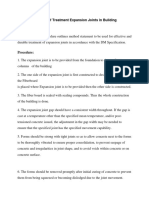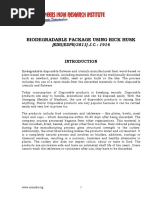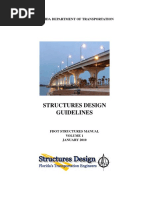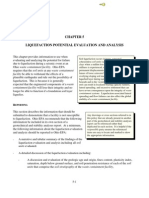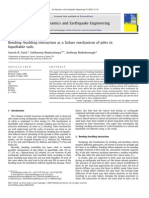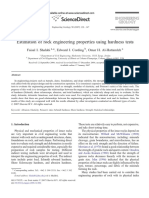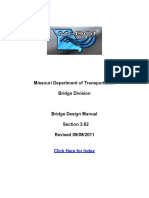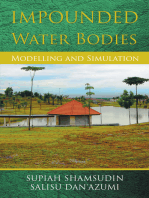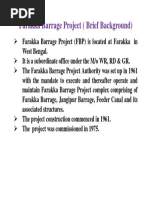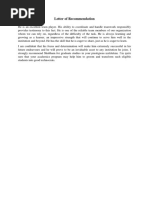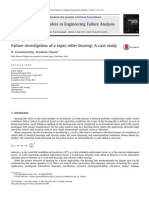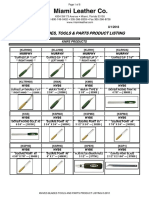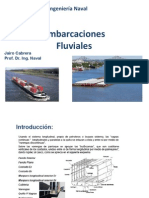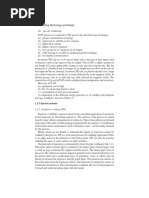Roller
Roller
Uploaded by
kapolaCopyright:
Available Formats
Roller
Roller
Uploaded by
kapolaOriginal Description:
Copyright
Available Formats
Share this document
Did you find this document useful?
Is this content inappropriate?
Copyright:
Available Formats
Roller
Roller
Uploaded by
kapolaCopyright:
Available Formats
Roller-Compacted Concrete Dams
The first step to Knowledge is to know that we are ignorant) Cecil
OMER A. BILBAS omerbilbas@yahoo.com
Introduction
Dams are among the most important and beautiful creation of mankind. They usually surpass other constructions in volume and cost, as well as in social importance and risk. Gravity masonry dams which were predominantly developed by Egyptians, Greeks and Romans lasted thousands of years. Dams require the most developed methods of construction and design, and organization of their building requires the most important skills and the widest experience in civil engineering. Concrete dams have some intrinsic advantages over the fill type structure, they are resistant to
erosion and maintenance is usually less than required for a fill type structure. On account at construction joints, concrete dams have the advantage of preventing temperature cracks, but the complicated arrangement for pipe cooling and joint grouting make them less economical than the conventional embankment dams. Thus, a new construction approach seems necessary for future concrete dams. The new method must not only be better from economic considerations but must be simple quick and with less technical problems inherent in mass concrete construction.
@ @MMMMMMMMMMMMMMMMMMMMMMMMMMMMMMMMMMMMMMMMMMMMMMMMMMMMM MMMMMMMMMMMMMMMMMMMMMMMMMMMMMMMMMMMMMMMMMMMMMMMMMMMMMMMMMMMMMMMMMMMM @ @HQYQ @@@@@I@@@@@@@@@@@@@@@@@@@@@@@@@@@@@@@@@@@@@@@@@@@@@@@@@@@@@@@@@@@@@@@@@@@@@@@@@@@@@@@@@@@@@@@@@@@@@@@@@@@@@@@@@@@@@@@@@@@@@@@@@@@@@@@@@@@@@@@@@@@@@@@@@@@ @@RWPW@b@HQRQQIb@@@@@@@@@
What is Roller Compacted Concrete
Roller compacted concrete (RCC) is a dry (concrete) material that has been consolidated by external vibration utilizing vibratory rollers. It differs from conventional concrete principally in its required consistency. For effective consolidation, RCC must be dry enough to support the weight of the vibratory equipment but wet enough to permit adequate distribution of paste binder throughout the mass during the mixing and vibration process. The consistency requirements have a direct effect on the mixed proportion requirements. The term roller- compacted concrete describes concrete used in the construction process, which combines the economical, and rapid placing techniques used for fill dams with the strength and durability of concrete. RCC is concrete with a no-slump consistency in its unhardened state that is transported, placed, and compacted using fill dam construction equipment. The properties of hardened RCC are similar to those of traditionally-placed concrete. Placement of RCC is in horizontal layers similar to the techniques of earth and rock-fill dams. The dry, nonflowable nature of RCC makes the use of a wide range of equipment for construction and continuous placement possible. End and bottom dump trucks and /or conveyors can be used for transporting concrete from the mixer to the dam. Mechanical spreaders, such as caterpillars and graders, place the material in layers or lifts .Selfpropelled, vibratory, steel-wheeled, or pneumatic rollers along with the dozers perform the compaction (figure1).
The thickness of the placement layers, ranging from (20 to 60 cm) is established by the compaction capabilities. With the flexibility of using the above equipment and continuous placement, RCC dams can be constructed at significantly higher rates than those achievable with conventional mass concrete. Using this construction procedure RCC dams can be raised at a rate close to (10m) per month or more .The number of joints between the relatively thin layers and the related quality control can have a large influence on the overall stability of the dam in term of uplift water pressure, tensile and shear (cohesion) strength at the joints between the layers. The majority of RCCs contain mineral admixtures, commonly fly ash, as an active constitute of the concrete and one of the major advance in concrete technology brought about by the development of the RCC dam has been the greater understanding of the performance of mineral admixtures in concrete. The objective of RCC dams is to place, as much concretes possible without construction joints to maximize production and to reduce the costs associated with the treatment of joints. A typical cross section of an RCC dam is shown in (figure2)
Brief History of RCC Dams
The first dams to be built of RCC were gravity dams and this type remains by far the most common. Nevertheless by the end of 1996 there were two examples arch-gravity RCC dams in South Africa, one arch RCC dam in China .The properties that can be achieved with RCC are more than adequate for the slightly
@ @MMMMMMMMMMMMMMMMMMMMMMMMMMMMMMMMMMMMMMMMMMMMMMMMMMMMMMMMMMMMMMMMMMMMMMMMMMMMMMMMMMMMMMMMMMMMMMMMMMMMMMMMMMMMMMMMMMMMMMMMM H@@@@@@@ @@RWPW@b@HQRQQIb@@@@@@@@@ QYP I@@@@@@@@@@@@@@@@@@@@@@@@@@@@@@@@@@@@@@@@@@@@@@@@@@@@@@@@@@@@@@@@@@@@@@@@@@@@@@@@@@@@@@@@@@@@@@@@@@@@@@@@@@@@@@@@@@@@@@@@@@@@@@@@@@@@@@@@@@@@@@@@@@@
References 1-Roller-Compacted Concrete Dams, Bulletin 126-2003, International Commission on Large Dams (ICOLD) 2-Roller Compacted Concrete Dam, by V.K Mehrotra, First Edition; 2004. @ @MMMMMMMMMMMMMMMMMMMMMMMMMMMMMMMMMMMMMMMMMMMMMMMMMMMMM MMMMMMMMMMMMMMMMMMMMMMMMMMMMMMMMMMMMMMMMMMMMMMMMMMMMMMMMMMMMMMMMMMMM @ @HQXY @@@@@I@@@@@@@@@@@@@@@@@@@@@@@@@@@@@@@@@@@@@@@@@@@@@@@@@@@@@@@@@@@@@@@@@@@@@@@@@@@@@@@@@@@@@@@@@@@@@@@@@@@@@@@@@@@@@@@@@@@@@@@@@@@@@@@@@@@@@@@@@@@@@@@@@@@ @@RWPW@b@HQRQQIb@@@@@@@@@
increased loading with these sections when compared to the traditional gravity section. RCC has also been used for a considerable number of coffer dams where the advantage of speed of construction can be fully utilized, some RCC cofferdams have been constructed at vertical rates of over 30m/month.In addition some have been overtopped at an early age without damage. The interest in RCC dams is driven by economic considerations and also where speed of construction is an important element. Given an adequate foundation, RCC dams commonly have a lower cost than the equivalent fill dams when the saving in cost of diversions and spillways are taken into account. Roller-compacted concrete has been in regular use since the last 1920s mostly as a base for highways and airfield pavements .In this application it is commonly known as leanmix or dry-lean concrete and similar terms. The first suggestion that RCC could be used in dam construction was in 1941 in the cofferdam (Chinese Taipei-Taiwan) .The concrete was used as an impervious core and was placed using earth-fill methods and was roller compacted. The first use of RCC in large volumes was at Tarbela Dam (Pakistan) in 1975 and the first major RCC dam was the 52-m high in (USA) completed in 1982.The RCC in this dam had a low cementitious content in the dam body (47 kg/m3) of cement and (19 kg/m3) of mineral admixtures .Pre-cast concrete panels formed the up stream face. The next RCC dam was the 40m high (Australia) completed in 1984 .This dam contained an RCC with 80Kg/m3 of cement in the central zone and 80Kg/m3 of cement and 30Kgm3 flyash in the outer zones of the dam. In 1985 and 1986 two dams on opposite sides of the world (Spain and China) introduced the concept of using higher cementitious content in RCC with a high proportion of mineral admixtures .These two dams were the first dams by two of the countries now leading the development of RCC for dam construction. Soon after these dams, RCC dams were also initiated in South Africa, Brazil and Mexico. With greater experience and gain in confidence in the material, the next step forward for RCC was the extension of its use to
arch-gravity and eventually arches dams. Essentially RCC has effectively replaced traditional concrete for the construction of dams.
ADVANTAGES OF RCC DAM CONSTRUCTION The advantages of the RCC dam method of construction are many. Some of the advantages are primarily applicable with certain types of mixtures , structural designs, production methods, weather or other conditions .Each RCC project must therefore be thoroughly evaluated based on technical merit and cost and compared with alternative methods of construction. The major advantages of RCC in dam construction as compared with traditional-concrete dams include: 1-More rapid construction (2.5 to 3m vertical progress per week can be achieved in larger rates has been achieved in smaller dams). -Effective use of conventional equipment (trucks, dozers, vibratory, rollers, etc) -A reduced cost of construction as a sequence of the above. 4-Thinner layers which lead to increased safety during construction by reducing the differences in levels between placements. -Safety is also enhanced by the reduced dependence on formwork. 6 -Shorter river diversions (both in terms of length and time) during construction. 7 -The dam is capable of passing floods during construction by over-topping without damage. At the end of 1986 there were only 15 compacted RCC dams in the world: six in the USA, two in each of South Africa, Australia, Japan, and one in each of Brazil, Spain and China .It is of interest that these seven countries are still leading proponents of RCC dam construction .At the end at 1996, there were at least 157 completed RCC dams and a further 32 were under construction. At the end of 1996 there were 157 completed RCC dams in some 20 countries. The countries that had completed RCC dams at the end of 1996 are shown in the tableNo. (1): Nowadays close to 343 RCC dams completed or under construction as shown in the table No. (2);
Besides its use in dams, RCC can find economical use in the construction of roads, airport runways, seaport pavements and berths, mass concrete floors, check dams large size water storage tanks, large size stilling basins, etc.
Asia China Japan Kyrgyzstan Thailand Total Europe Spain France Romania Greece Total Africa South Africa Morocco Angola Total
No. 23 28 1 1 53 19 6 2 1 28 11 7 1 19
North America USA Mexico Canada Total South America Brazil Honduras Argentina French Guyana Chile Total Oceania Australia Total Grant Total 28 5 2 35 9 2 1 1 1 14 8 8 157
No.
Table No. (1) North America USA Mexico Canada Total South America Brazil Honduras Argentina French Guyana Chile Total Oceania Australia Total Gant Total 11 11 343 No. 39 7 2 48 37 2 1 1 2 43
Asia China Japan Kyrgyzstan Thailand Iran India Jordan Philippines Total Europe Spain France Romania Greece Turkey Total Africa South Africa Morocco Angola Algeria Tunisia UAE Vietnam Total
No. 102 46 1 3 2 3 3 2 162 22 6 2 5 4 39 14 15 2 2 2 6 42
Table No. (2)
@ @MMMMMMMMMMMMMMMMMMMMMMMMMMMMMMMMMMMMMMMMMMMMMMMMMMMMMMMMMMMMMMMMMMMMMMMMMMMMMMMMMMMMMMMMMMMMMMMMMMMMMMMMMMMMMMMMMMMMMMMMM H@@@@@@@ @@RWPW@b@HQRQQIb@@@@@@@@@ QXXI@@@@@@@@@@@@@@@@@@@@@@@@@@@@@@@@@@@@@@@@@@@@@@@@@@@@@@@@@@@@@@@@@@@@@@@@@@@@@@@@@@@@@@@@@@@@@@@@@@@@@@@@@@@@@@@@@@@@@@@@@@@@@@@@@@@@@@@@@@@@@@@@@@@
You might also like
- Method Statement of Treatment Expansion Joints in BuildingDocument4 pagesMethod Statement of Treatment Expansion Joints in BuildingGhaffar Laghari100% (3)
- Pipeline List of Deliverables - GarmianDocument1 pagePipeline List of Deliverables - GarmianPriyam Km100% (1)
- Gravity Retaining Wall CollapseDocument7 pagesGravity Retaining Wall CollapseIanNo ratings yet
- Flexible Pavement Structural Section Design Guide FOR California Cities and CountiesDocument56 pagesFlexible Pavement Structural Section Design Guide FOR California Cities and CountiesAsghar Hussain ShahNo ratings yet
- Marketing Plan Construction MachineryDocument17 pagesMarketing Plan Construction MachineryShailesh KhodkeNo ratings yet
- Manufacturing Technology: Unit - IDocument18 pagesManufacturing Technology: Unit - Iapi-271354682100% (1)
- Project Report On Biodegradable Package Using Rick HuskDocument8 pagesProject Report On Biodegradable Package Using Rick HuskEIRI Board of Consultants and Publishers0% (1)
- Basic Design Approach For Geogrid Base ReinforcementDocument3 pagesBasic Design Approach For Geogrid Base ReinforcementTrader RedNo ratings yet
- Structures Design Guidelines: Florida Department of TransportationDocument258 pagesStructures Design Guidelines: Florida Department of TransportationdiablopapanatasNo ratings yet
- Design PDFDocument260 pagesDesign PDFPrf El-SakhawyNo ratings yet
- Permeability - 4 MtechDocument70 pagesPermeability - 4 MtechViky ShahNo ratings yet
- AB Engineering Manual - Retaining WallDocument82 pagesAB Engineering Manual - Retaining Wallben indrawanNo ratings yet
- Design of A Retaining WallDocument3 pagesDesign of A Retaining WallHenra HalimNo ratings yet
- THE Design OF Upright Breakwaters: Depart - Ent of Civil Engineering Yokoha.a National University, Yokoha.a 240, JapanDocument22 pagesTHE Design OF Upright Breakwaters: Depart - Ent of Civil Engineering Yokoha.a National University, Yokoha.a 240, JapanJemi JollyNo ratings yet
- RCCBoxDocument31 pagesRCCBoxSujith SurendranNo ratings yet
- Slab Bridge DesignDocument1 pageSlab Bridge DesignMars VillalunaNo ratings yet
- Retaining Walls: A.B.C.MDocument23 pagesRetaining Walls: A.B.C.MnilminaNo ratings yet
- Retainingwall 140712100253 Phpapp02 PDFDocument67 pagesRetainingwall 140712100253 Phpapp02 PDFDr-Hany HashishNo ratings yet
- Seismic Design of Bridges Example 8Document36 pagesSeismic Design of Bridges Example 8Mike2322No ratings yet
- Shear Design of Beams PDFDocument7 pagesShear Design of Beams PDFBlend DlerNo ratings yet
- Culvert CatalogDocument13 pagesCulvert CatalogmehmilNo ratings yet
- Numerical Analysis of Piled Raft Foundation in Sandy and Clayey SoilsDocument4 pagesNumerical Analysis of Piled Raft Foundation in Sandy and Clayey Soilspperic13No ratings yet
- BQS552 Earth Retaining StructureDocument93 pagesBQS552 Earth Retaining StructureShakir ZufayriNo ratings yet
- LicuefaciónDocument8 pagesLicuefaciónDaisy FloresNo ratings yet
- Articulated Concrete Block DesignDocument8 pagesArticulated Concrete Block DesignRashid MinhajNo ratings yet
- The Seismic Design of Waterfront Retaining Structures PDFDocument328 pagesThe Seismic Design of Waterfront Retaining Structures PDFdyc123No ratings yet
- Noc18 Ce23 Assignment2 PDFDocument4 pagesNoc18 Ce23 Assignment2 PDFrichard kwofieNo ratings yet
- STAAD ProDocument1 pageSTAAD ProkamalnitrrNo ratings yet
- Uplift Capacity Shall Be Taken As 0.7 Times The Shaft Resistance, With A Factor of Safety of 2.5Document3 pagesUplift Capacity Shall Be Taken As 0.7 Times The Shaft Resistance, With A Factor of Safety of 2.5Ajay KumarNo ratings yet
- Floating BridgeDocument9 pagesFloating BridgemadhavithakurNo ratings yet
- 2.5m Wall - 2m SSHDocument15 pages2.5m Wall - 2m SSHSripara KrishnaNo ratings yet
- bn#17 101 EnercalcDocument1 pagebn#17 101 EnercalcBao NguyenNo ratings yet
- Evaluation of Shear Resistance of High Strength Concrete Beams Without Web Reinforcement Using AnsysDocument7 pagesEvaluation of Shear Resistance of High Strength Concrete Beams Without Web Reinforcement Using AnsysHuda JawadNo ratings yet
- 3D Modeling of Piled Raft Foundation Sub PDFDocument9 pages3D Modeling of Piled Raft Foundation Sub PDFArmando Farfan NiñoNo ratings yet
- Arch & Buttres DamDocument24 pagesArch & Buttres DamManoj LanghiNo ratings yet
- Alternative Forms of Two Lane T-Beam Bridge Superstructure - Study by Grillage AnalogyDocument9 pagesAlternative Forms of Two Lane T-Beam Bridge Superstructure - Study by Grillage AnalogyAnkur SrivastavaNo ratings yet
- Case Histories On The Use of Helical Piles For Retrofitting and New ConstructionDocument6 pagesCase Histories On The Use of Helical Piles For Retrofitting and New ConstructionLeonardo SanchezNo ratings yet
- Retaining Wall Design (Final)Document6 pagesRetaining Wall Design (Final)ifylasyNo ratings yet
- Formulae: Two-Way Shear With Negligible Moment TransferDocument7 pagesFormulae: Two-Way Shear With Negligible Moment TransferKory EstesNo ratings yet
- 22m High Wall at Durga Temple With PECDocument5 pages22m High Wall at Durga Temple With PECGerald TanNo ratings yet
- Tutorial 14 Cofferdam SeepageDocument12 pagesTutorial 14 Cofferdam SeepageCarlos Eduardo TorresNo ratings yet
- Soil Dynamics and Earthquake Engineering: Suresh R. Dash, Subhamoy Bhattacharya, Anthony BlakeboroughDocument8 pagesSoil Dynamics and Earthquake Engineering: Suresh R. Dash, Subhamoy Bhattacharya, Anthony Blakeboroughuchiha894354No ratings yet
- Anchorage & Lap LengthDocument1 pageAnchorage & Lap LengthHrushikesh Patel100% (1)
- Fill Height TablesDocument16 pagesFill Height TablesDipendra ShresthaNo ratings yet
- CH-2 Caissons and CofferdamsDocument9 pagesCH-2 Caissons and CofferdamsAsegid Bezabih100% (1)
- RCCDocument11 pagesRCCImam Nazmus SalehinNo ratings yet
- Dowel Bar RetrofitDocument28 pagesDowel Bar RetrofitArunashish Mazumdar100% (1)
- Fresh Kills ParkDocument18 pagesFresh Kills Parkheya16No ratings yet
- New Piles Installation SystemsDocument38 pagesNew Piles Installation SystemsAnand JadoenathmisierNo ratings yet
- DRAFTAAE LRFDGuidlines2017-V6Document374 pagesDRAFTAAE LRFDGuidlines2017-V6Evaresto Cole MalonesNo ratings yet
- Estimation of Rock Engineering Properties Using Hardness TestsDocument10 pagesEstimation of Rock Engineering Properties Using Hardness TestsAbdul Bari ZiaNo ratings yet
- 751.24 LFD Retaining Walls Sept 2011 PDFDocument94 pages751.24 LFD Retaining Walls Sept 2011 PDFIjaz ShahNo ratings yet
- Design of Sheet Pile Walls US ArmyDocument38 pagesDesign of Sheet Pile Walls US ArmyDesai NileshNo ratings yet
- P 1597 - Cellular Cofferdams-Developments in Design and Analysis PDFDocument12 pagesP 1597 - Cellular Cofferdams-Developments in Design and Analysis PDFsagarsjce100% (1)
- Loads On BuildingsDocument15 pagesLoads On BuildingsSrinivas VogguNo ratings yet
- Lateral Load Pile Scour DepthDocument9 pagesLateral Load Pile Scour DepthPalak ShivhareNo ratings yet
- Theory Manual ENG 2011Document117 pagesTheory Manual ENG 2011Bza ZaBugNo ratings yet
- Structural Design Sample Exams-95-96-97-98Document73 pagesStructural Design Sample Exams-95-96-97-98Arnel FreoNo ratings yet
- A Catalogue of Details on Pre-Contract Schedules: Surgical Eye Centre of Excellence - KathFrom EverandA Catalogue of Details on Pre-Contract Schedules: Surgical Eye Centre of Excellence - KathNo ratings yet
- Towards A Unified Soil Mechanics Theory: The Use of Effective Stresses in Unsaturated Soils, Revised EditionFrom EverandTowards A Unified Soil Mechanics Theory: The Use of Effective Stresses in Unsaturated Soils, Revised EditionNo ratings yet
- Design of Piles Under Cyclic Loading: SOLCYP RecommendationsFrom EverandDesign of Piles Under Cyclic Loading: SOLCYP RecommendationsAlain PuechNo ratings yet
- ACARA - NAPLAN Preliminary Results - Data Dictionary: OfficialDocument5 pagesACARA - NAPLAN Preliminary Results - Data Dictionary: OfficialkapolaNo ratings yet
- Execution of Hydro Power Plant - PLANNING AND OPERATIONDocument49 pagesExecution of Hydro Power Plant - PLANNING AND OPERATIONkapolaNo ratings yet
- Partially Dissected View of Raft: Special Projects BU Heavy Civil Ic 1Document2 pagesPartially Dissected View of Raft: Special Projects BU Heavy Civil Ic 1kapolaNo ratings yet
- Thermal Analysis of Medigada BarrageDocument1 pageThermal Analysis of Medigada BarragekapolaNo ratings yet
- Concrete Cooling Systems: Years of ExperienceDocument7 pagesConcrete Cooling Systems: Years of ExperiencekapolaNo ratings yet
- Farakka Barrage Project (Other Components) : Left Afflux Bund of Farakka Barrage - 33.79 KM inDocument1 pageFarakka Barrage Project (Other Components) : Left Afflux Bund of Farakka Barrage - 33.79 KM inkapolaNo ratings yet
- Farakka Barrage Project (Main Objectives) : To Divert Adequate Quantity of Ganga Waters IntoDocument1 pageFarakka Barrage Project (Main Objectives) : To Divert Adequate Quantity of Ganga Waters IntokapolaNo ratings yet
- Farakka Barrage Project: Serving The Nation Since 1975Document1 pageFarakka Barrage Project: Serving The Nation Since 1975kapolaNo ratings yet
- Farakka Barrage Project (Brief Background) : West BengalDocument1 pageFarakka Barrage Project (Brief Background) : West BengalkapolaNo ratings yet
- Nonlinear Seismic Analyses of A High Gravity Dam With and Without The Presence of ReinforcementDocument18 pagesNonlinear Seismic Analyses of A High Gravity Dam With and Without The Presence of ReinforcementkapolaNo ratings yet
- Letter of RecommendationDocument1 pageLetter of RecommendationkapolaNo ratings yet
- Survey Welding-Standards 14-10-2015Document1 pageSurvey Welding-Standards 14-10-2015givaliNo ratings yet
- Catalogue For DaiHan Anchor Chain MFGDocument20 pagesCatalogue For DaiHan Anchor Chain MFGthlim19078656No ratings yet
- NXDocument6 pagesNXKabil RajNo ratings yet
- HP - Supplying The DeskJet Printer in EuropeDocument4 pagesHP - Supplying The DeskJet Printer in Europeroberto0% (1)
- Iron and Steel IndustryDocument17 pagesIron and Steel IndustryEMJAY100% (1)
- Uses of Sulphuric Acid in Manufacturing of Caprolactum Used in Synthesis of NylonDocument4 pagesUses of Sulphuric Acid in Manufacturing of Caprolactum Used in Synthesis of NylonmastmonaNo ratings yet
- Executive Shirt Company Case Analysis - Group 4Document7 pagesExecutive Shirt Company Case Analysis - Group 4Rahul HermanNo ratings yet
- The Conversion Cycle: Principles of Accounting Information Systems, Asia EditionDocument31 pagesThe Conversion Cycle: Principles of Accounting Information Systems, Asia EditionKurt OrfanelNo ratings yet
- Agile Manufacturing Paradigms-Case Study Agile Manufacturing Paradigms - Case StudyDocument36 pagesAgile Manufacturing Paradigms-Case Study Agile Manufacturing Paradigms - Case StudyshuklaNo ratings yet
- Hydrogen Production by Steam Reforming Chemical Engineering ProcessingDocument8 pagesHydrogen Production by Steam Reforming Chemical Engineering ProcessingviettiennguyenNo ratings yet
- Bridon Construction ProductsDocument16 pagesBridon Construction ProductsAnonymous UebIaD8A8CNo ratings yet
- Fire ScaleDocument2 pagesFire Scale4U6ogj8b9snylkslkn3nNo ratings yet
- Wireless SolutionDocument2 pagesWireless SolutionCNo ratings yet
- Studi Kasus Analisa Kegagalan BahanDocument5 pagesStudi Kasus Analisa Kegagalan BahanRizky SyahputraNo ratings yet
- Efficient Consumer Response PDFDocument5 pagesEfficient Consumer Response PDFSafijo AlphonsNo ratings yet
- Knives, Blades, Tools & Parts Product Listing: Knife ProductsDocument8 pagesKnives, Blades, Tools & Parts Product Listing: Knife ProductsWilberth FrancoNo ratings yet
- Embarcaciones FluvialesDocument21 pagesEmbarcaciones FluvialesHarold Valle ReyesNo ratings yet
- BelzonaDocument3 pagesBelzonaIslandcrisis SinoeNo ratings yet
- About Welding Process 38Document1 pageAbout Welding Process 38XerexNo ratings yet
- CastingDocument21 pagesCastingVinitJoryNo ratings yet
- Systematic Layout PlanningDocument45 pagesSystematic Layout Planningkevin punzalan94% (31)
- Acoustical MaterialsDocument3 pagesAcoustical MaterialsMary Faye Reyes100% (2)
- CM Company ProfileDocument11 pagesCM Company ProfilePreet Inder SinghNo ratings yet
- Blister PackagingDocument19 pagesBlister PackagingMohd Ezan MohammadiahNo ratings yet
